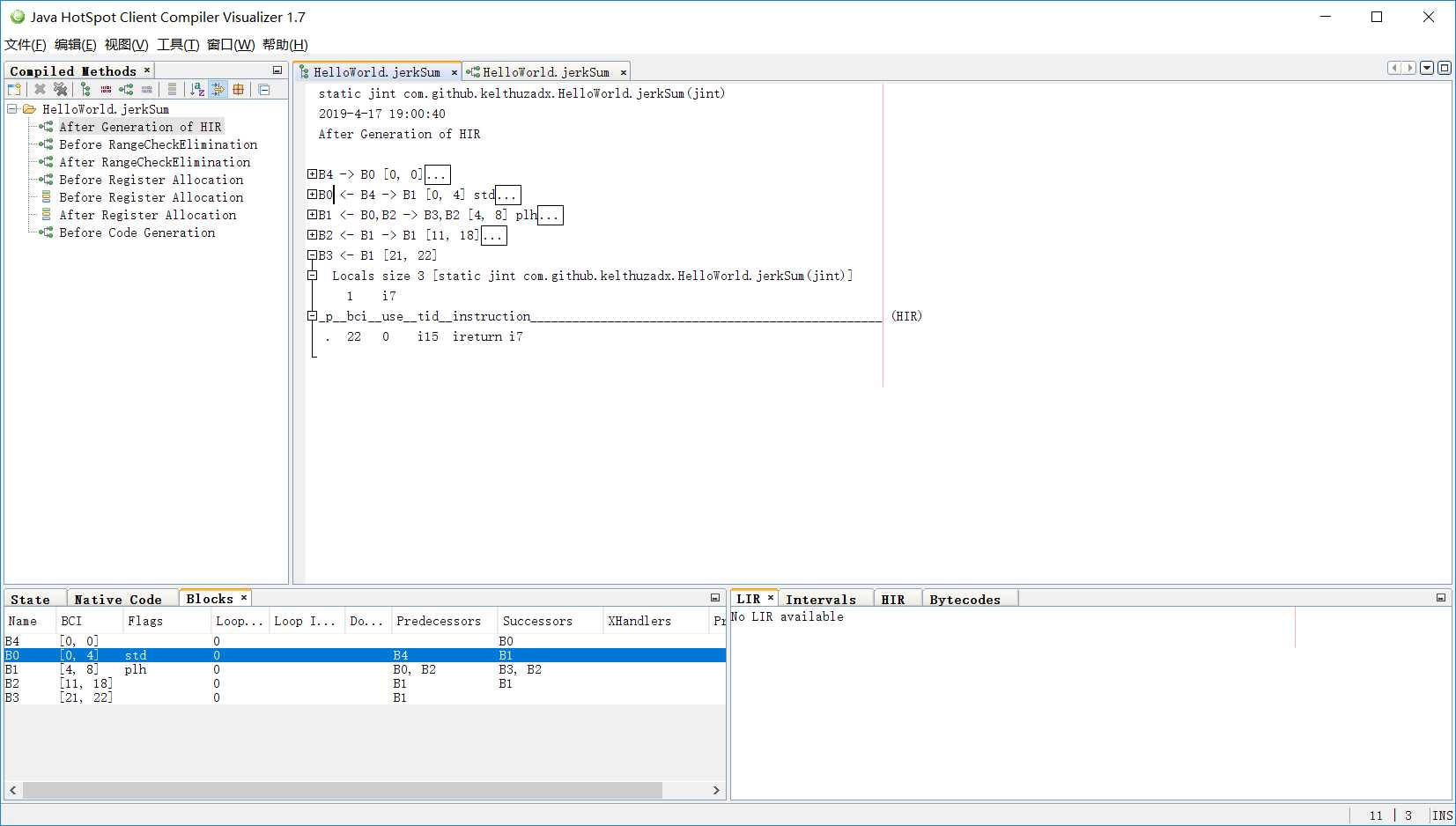标签:src begin hello method 简介 png ges pat 构造
C1编译器(aka Client Compiler)的代码位于hotspot\share\c1。C1编译线程(C1 CompilerThread)会阻塞在任务队列,当发现队列有编译任务即可CompileTask的时候,线程唤醒然后调用CompilerBroker,CompilerBroker再进一步选择合适编译器,以此进入JIT编译器的世界。

CompilerBroker到C1编译器进行JIT编译的调用栈如下:
CompileBroker::invoke_compiler_on_method()
-> Compiler::compile_method()
-> Compilation::Compilation()
-> Compilation::compile_method()
-> Compilation::compile_java_method()在compile_java_method()方法中完成了C1编译最主要的流程:
int Compilation::compile_java_method() {
if (BailoutOnExceptionHandlers) {
if (method()->has_exception_handlers()) {
bailout("linear scan can't handle exception handlers");
}
}
if (is_profiling() && !method()->ensure_method_data()) {
BAILOUT_("mdo allocation failed", no_frame_size);
}
// 构造HIR
{
PhaseTraceTime timeit(_t_buildIR);
build_hir();
}
if (BailoutAfterHIR) {
BAILOUT_("Bailing out because of -XX:+BailoutAfterHIR", no_frame_size);
}
// 构造LIR
{
PhaseTraceTime timeit(_t_emit_lir);
_frame_map = new FrameMap(method(), hir()->number_of_locks(), MAX2(4, hir()->max_stack()));
emit_lir();
}
CHECK_BAILOUT_(no_frame_size);
// 生成机器代码
{
PhaseTraceTime timeit(_t_codeemit);
return emit_code_body();
}
}C1编译器(Client Compiler)将字节码转化为SSA-based HIR(Single Static Assignment based High-Level Intermediate Representation)。HIR即高级中间表示,我们用Java写代码,编译得到字节码。但即便是字节码对于编译器优化来说也不太理想,
编译器会使用一种更适合优化的形式来表征字节码。这个更适合优化的形式就是HIR,HIR又有很多,有些是图的形式,有些是线性的形式,
HotSpot C1使用的是一种基于SSA的图IR,它可以高效的做数据流分析和控制流分析,是编译优化常用的一种IR。那么什么又是SSA呢?SSA表示静态单赋值,每个变量都仅被赋值一次。举个例子:
// 源码
int foo(){
int a = 6;
a = 8;
return a;
// SSA表示
foo:
a1 = 6
a2 = 8
return a2这段代码里a最开始的赋值是多余的,如果用SSA表示这段代码,编译器很容易发现a1这个值在foo块中没有使用,直接优化为:
foo:
a2 = 8
return a2SSA还有很多好处,这里只是一个小的方面,有兴趣的可以阅读编译理论方面的书籍,入门推荐《编译器设计》和《编译原理》。
回到主题,我们常说的C1编译器优化大部分都是在它之上完成的。当优化完成之后它会将HIR转化为LIR(Low-Level Intermediate Representation),LIR又是一种编译器内部用到的表示,这种表示消除了HIR中的PHI节点,然后使用LSRA(Linear Scan Register Allocation,线性寄存器分配算法)将虚拟寄存器映射到物理寄存器,最后再将LIR转化为CPU相关的机器码,完成JIT工作。

build_hir()不仅会构造出HIR,还会执行很多平台无关的代码优化。代码优化不用多讲,JVM给我们带来性能上的信心很大程度上都源于此,这是评判JIT编译器的重要指标,也是编译器后端的主要任务。
void Compilation::build_hir() {
CHECK_BAILOUT();
// 创建HIR
CompileLog* log = this->log();
if (log != NULL) {
log->begin_head("parse method='%d' ",
log->identify(_method));
log->stamp();
log->end_head();
}
{
PhaseTraceTime timeit(_t_hir_parse);
_hir = new IR(this, method(), osr_bci());
}
if (log) log->done("parse");
if (!_hir->is_valid()) {
bailout("invalid parsing");
return;
}
#ifndef PRODUCT
if (PrintCFGToFile) {
CFGPrinter::print_cfg(_hir, "After Generation of HIR", true, false);
}
#endif
#ifndef PRODUCT
if (PrintCFG || PrintCFG0) { tty->print_cr("CFG after parsing"); _hir->print(true); }
if (PrintIR || PrintIR0 ) { tty->print_cr("IR after parsing"); _hir->print(false); }
#endif
// 验证HIR
_hir->verify();
// 优化:条件表达式消除,基本块消除
if (UseC1Optimizations) {
NEEDS_CLEANUP
// optimization
PhaseTraceTime timeit(_t_optimize_blocks);
_hir->optimize_blocks();
}
_hir->verify();
_hir->split_critical_edges();
#ifndef PRODUCT
if (PrintCFG || PrintCFG1) { tty->print_cr("CFG after optimizations"); _hir->print(true); }
if (PrintIR || PrintIR1 ) { tty->print_cr("IR after optimizations"); _hir->print(false); }
#endif
_hir->verify();
// compute block ordering for code generation
// the control flow must not be changed from here on
_hir->compute_code();
// 优化:全局值编号优化
if (UseGlobalValueNumbering) {
// No resource mark here! LoopInvariantCodeMotion can allocate ValueStack objects.
PhaseTraceTime timeit(_t_gvn);
int instructions = Instruction::number_of_instructions();
GlobalValueNumbering gvn(_hir);
assert(instructions == Instruction::number_of_instructions(),
"shouldn't have created an instructions");
}
_hir->verify();
#ifndef PRODUCT
if (PrintCFGToFile) {
CFGPrinter::print_cfg(_hir, "Before RangeCheckElimination", true, false);
}
#endif
// 优化:范围检查消除
if (RangeCheckElimination) {
if (_hir->osr_entry() == NULL) {
PhaseTraceTime timeit(_t_rangeCheckElimination);
RangeCheckElimination::eliminate(_hir);
}
}
#ifndef PRODUCT
if (PrintCFGToFile) {
CFGPrinter::print_cfg(_hir, "After RangeCheckElimination", true, false);
}
#endif
// 优化:null检查消除
if (UseC1Optimizations) {
// loop invariant code motion reorders instructions and range
// check elimination adds new instructions so do null check
// elimination after.
NEEDS_CLEANUP
// optimization
PhaseTraceTime timeit(_t_optimize_null_checks);
_hir->eliminate_null_checks();
}
_hir->verify();
// compute use counts after global value numbering
_hir->compute_use_counts();
#ifndef PRODUCT
if (PrintCFG || PrintCFG2) { tty->print_cr("CFG before code generation"); _hir->code()->print(true); }
if (PrintIR || PrintIR2 ) { tty->print_cr("IR before code generation"); _hir->code()->print(false, true); }
#endif
_hir->verify();
}build_hir()第一阶段解析字节码生成HIR;对其进行条件表达式消除,基本块消除;接着使用全局值编号(GVN,Global Value Numbering);第二阶段消除一些数组范围检查(Range Check Elimination);最后做NULL检查消除(OpenJDK12版本的C1没有逃逸分析!不要听网上乱说)。
这些都是编译器后端优化的知识,下次有空可以专门写篇关于这些优化的文章...
如果JVM是fastdebug版,加上-XX:+PrintIR参数可以输出每一个步骤的HIR:
(我使用的完整参数是:-XX:+UnlockDiagnosticVMOptions -XX:+PrintCompilation -XX:CompileCommand=compileonly,com.github.kelthuzadx.HelloWorld::jerkSum -Xcomp -XX:TieredStopAtLevel=1 -XX:+PrintIR -XX:+PauseAtExit)
17669 28 b 1 com.github.kelthuzadx.HelloWorld::jerkSum (23 bytes)
IR after parsing
B4 [0, 0] -> B0 sux: B0
empty stack
inlining depth 0
__bci__use__tid____instr____________________________________
. 0 0 17 std entry B0
B0 (SV) [0, 4] -> B1 sux: B1 pred: B4
empty stack
inlining depth 0
__bci__use__tid____instr____________________________________
2 0 i5 0
. 4 0 6 goto B1
B1 (LHV) [4, 8] -> B3 B2 sux: B3 B2 pred: B0 B2
Locals:
1 i7 [ i4 i11]
2 i8 [ i5 i13]
empty stack
inlining depth 0
__bci__use__tid____instr____________________________________
5 0 i9 10000
. 8 0 10 if i8 >= i9 then B3 else B2
B2 (V) [11, 18] -> B1 sux: B1 pred: B1
empty stack
inlining depth 0
__bci__use__tid____instr____________________________________
13 0 i11 i7 + i8
15 0 i12 1
15 0 i13 i8 + i12
. 18 0 14 goto B1 (safepoint)
B3 (V) [21, 22] pred: B1
empty stack
inlining depth 0
__bci__use__tid____instr____________________________________
. 22 0 i15 ireturn i7
....另外加上-XX:+PrintCFGToFile标志在字节码文件同目录下得到一个output_xx.cfg文件,里面的begin_block和end_block表示一个基本块;predecessors是当前块的前驱块;successors是后继块,这两个属性用于控制流的转移,以此构成CFG(Control Flow Graph);from_bci表示当前基本块对应的字节码起始偏移,to_bci表示对应的终止偏移;flags表示一些属性,比如该块是标准入口,还是OSR(On-Stack Replacement)入口,还是异常入口等;xhandlers表示异常处理器。
使用c1 visualizer还可以对它进行可视化:


C2使用图着色算法做寄存器分配;C1使用相对简单的线性扫描寄存器分配算法将虚拟寄存器映射到具体机器架构的物理寄存器上。更多LSRA内容请参见论文Linear Scan Register Allocation
for the Java HotSpot? Client Compiler
HotSpot对LIR也有很多虚拟机标志,都位于hotspot\share\c1\c1_global.hpp。比如-XX:+PrintLIR可以得到产出的LIR,-XX:+PrintLIRWithAssembly可以得到LIR对应的汇编表示。
说了这么多,不如来实战一下。我们准备了一段Java代码:
package com.github.kelthuzadx;
public class HelloWorld {
public static int jerkSum(int start){
int total = start;
for(int i=0;i<10000;i++){
total+=i;
}
return total;
}
public static void main(String[] args) {
System.out.println(jerkSum(1024));
}
}然后得到了对应的C1产出(-XX:+PrintLIRWithAssembly):
jerkSum:
;函数开始
0x000001999a7109a0: mov %eax,-0x9000(%rsp)
0x000001999a7109a7: push %rbp
0x000001999a7109a8: sub $0x30,%rsp
;int i = 0
0x000001999a7109ac: mov $0x0,%eax
0x000001999a7109b1: jmpq 0x000001999a7109b6
;循环开始
0x000001999a7109b6: nop
0x000001999a7109b7: nop
; total += i
0x000001999a7109b8: add %eax,%edx
; i++
0x000001999a7109ba: inc %eax
; 循环结束处插入安全点
34 safepoint [bci:18]
0x000001999a7109bc: mov 0x120(%r15),%r10
0x000001999a7109c3: test %eax,(%r10)
; i<10000
0x000001999a7109c6: cmp $0x2710,%eax
; 小于就跳到循环开始,否则结束循环
0x000001999a7109cc: jl 0x000001999a7109b8
; total放入rax,作为返回值
0x000001999a7109ce: mov %rdx,%rax
; 函数返回
0x000001999a7109d1: add $0x30,%rsp
0x000001999a7109d5: pop %rbp
0x000001999a7109d6: mov 0x120(%r15),%r10
0x000001999a7109dd: test %eax,(%r10)
0x000001999a7109e0: retq C1在一次循环结束(B2基本块)插入了一个安全点(Safepoint),也就是说每次循环结束都有机会进行垃圾回收,这样是有意义的:试想一个死循环里面一直new Object(),如果在循环体外面插入安全点,那么GC根本得不到执行就会内存溢出,所以必须在每次循环结束时插入安全点让GC可执行。然后这个例子C1没有做其他优化。
[Inside HotSpot] C1编译器工作流程及中间表示
标签:src begin hello method 简介 png ges pat 构造
原文地址:https://www.cnblogs.com/kelthuzadx/p/10740453.html